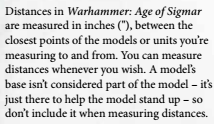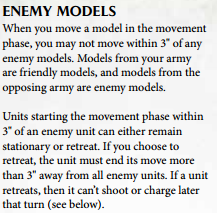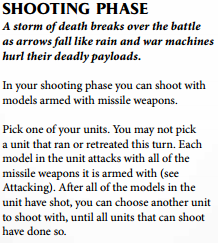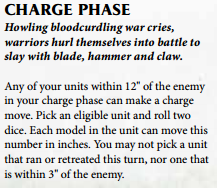Tabletop Game Review: Warhammer: Age of Sigmar (Part II – Game Mechanics and Conclusion)
The first part of this review of Warhammer: Age of Sigmar explained in some detail the game’s setup, army composition and terrain rules; this second article will explain the full turn sequence (accounting for two of the four pages of game rules). As a system it aims to be simple, efficient and quick to play; it achieves all of these aims inconsistently, although there are a number of good ideas to be found within it. Conceptually the shift in focus from ranked troops and formation movement to a freer, less regimented system is not unreasonable; a number of good alternative rule sets for blocks of troops in this fashion exist, considered to be of a generally higher quality than Games Workshop’s Warhammer Fantasy Battle eighth edition. However, even when considered as its own thing, not as a follow-up to a previous system it does not aim to emulate, I am unconvinced that Age of Sigmar is a particularly good streamlined fantasy game.
The Turn Phases
Turn order is set by a dice roll-off each turn, a mechanic used by several systems (Malifaux has players draw from a deck of cards, with the highest card winning, Dropzone Commander and Dystopian Wars and Firestorm Armada modify the initiative roll by the quality of the army general) but with one fundamental difference; Age of Sigmar has an “I go, You go” mechanic. Players play their entire turn, rather than alternating single unit or figure activations. As a result, rather than 50% of the time a player gets to activate two units in a row over the turn transition (which can be devastating in a combo-heavy game like Malifaux), 50% of the time a player will take two full turns in a row in a system which offers significant benefits on many units for charging or having activated. Being able to follow up a positioning turn with a charge, or chain-charge after wiping out a unit, or even simply put a large number of shots into a key target before it can do anything is a huge advantage. An unmodified dice roll feels inadequate for a decision of such importance as taking an entire army activation.
From there, play proceeds through six phases, detailed below:
1: Hero Phase
This is a general cleanup/magic/ability activation step; players cast spells with wizards if able, activate their leader’s “Command Ability” (a little like a feat in Warmachine but repeatable) and activate any other unit abilities that are appropriate. Some units have out-of-sequence abilities that can activate in the opponent’s turn. There is little to comment on here; it is a straightforward part of the game turn that does little remarkable.
Magic itself is simple and effective. Spells have a casting target number which must be achieved on two dice, and a rival wizard may try to counter the spell by beating that roll. Individual units have a statistic governing how many spells they may cast or counter a turn. The problem, if there is one, seems to be that spells are very easy to cast and the “basic” spells (a simple attack and armour upgrade) are often outclassed by a significant margin by anything specialised – the difference between “inflict d3 mortal wounds” and “inflict X mortal wounds with some other upside” being often only 2 or 3 points of casting difficulty – placing most spells between target values of 5 and 8. Slightly bizarrely, different mount options for wizards change their spell lists, so there is no way to take a, for example, Chaos Sorcerer with the Wind of Chaos spell (a very potentially useful spell) unless they are riding a Manticore.
2: Movement Phase
Movement is done on a per-unit basis, with all movement taking place before all combat etc. Quite strangely Age of Sigmar insists bases are “just there to help the model stand up” and measurement is done figure-to-figure, using the “closest points” of the model. This is astoundingly vague wording and, for a system trying to be simple and easily learned, weirdly inconsistent. Bases, of standard size and shape for each troop type, represent the simplest standardisation for consistent, abuse-free range measuring and movement. Individual models are intended to be converted, built in dynamic poses and so on; using such an infinitely variable method for determining the unit’s footprint seems antithetical to a simple, streamlined ruleset.
Conversely, the addition of a standardised 3” threat radius for models is a reasonable and clear move; a model within 3” of its enemies may either stay (and fight in a melee later in the turn) or retreat, with no penalty for disengaging, and forego its attacks. There are no disengaging strikes, attacks of opportunities or concepts of being locked in combat, and there are no positioning bonuses; this is a fairly major failing of the system. It removes a significant tactical option, over-streamlining the system. Not including these rules at all means that the game has very few choices beyond making the most optimal move to make attacks; even other games with free movement have some concept of engaging and locking enemies down (Malifaux has characters able to use long reach to attack without being counterattacked, Warmachine has an entire raft of rules involving tactical use of obstructing threat zones and Infinity has the highly elegant ARO mechanic encouraging outflanking).
Beyond this the only other movement rule is that a unit may roll a dice and add that to its Movement statistic to “run”, foregoing attacks. Terrain is vaguely defined.
3: Shooting Phase
Shooting is straightforward and uses a standardised attack method. Units may shoot all their ranged weapons at once every turn, which is not clearly defined in the unit profiles. A profile lists numerous ranged weapons, and then in typically vague Age of Sigmar fashion hides within a block of text who is armed with what – in the game I played several players assumed their models were armed with every listed weapon because the unit cards did not make it clear enough who carried what. There is no specification that being in melee or within 3” of an enemy precludes a unit from shooting, or indeed whether it can shoot a different target to the one it is in melee with. Indeed, it is not even clear whether enemy models impede line of sight, only that the player should “stoop down” to see if the target is visible. The intent seems to be enemy figures block line of sight, however.
Actually attacking involves rolling vast numbers of dice and is not particularly interesting owing to a lack of standardised modifiers and an over-reliance on per-unit modifiers to keep track of. Standardisation is key to a simplified system; instead Age of Sigmar tracks large numbers of arbitrary +1 bonuses and re-rolls unique to each unit and which are easily forgotten in large games. The attack sequence is the classic Games Workshop “to hit → to wound → save” sequence, although instead of comparative statistics units have fixed values modified by 1 or re-rolled by some modifier. This is a very dull rule decision, making units equally efficient against every target and removing all modifiers for range, positioning and movement. Cover is a simple +1 to save, and weapons have straightforward statistics – fixed to hit and wound values, a number of wounds inflicted per wounding hit, and an armour save modifier. Multi-wound weapons will carry over wounds to further enemies (so a cannonball inflicting D6 wounds will potentially kill 1-6 single hit point enemies), another simplification of questionable value; one of the interesting things in Fantasy Battle was a tradeoff between weapons efficient at killing hard opponents with many wounds (like cannonballs) and weapons that could hit multiple enemies more easily – the difference between attacks and wounds inflicted. “Damage” in Age of Sigmar is instead a multiplier applied to unsaved wounds.
The other complication in the attack sequence is the Mortal Wound, which does not require “hit, wound or save rolls” and simply inflicts direct damage.
What all this boils down to is a system in which most individual rolls have a 33-67% chance of success (either needing 3+, 4+ or 5+ on a six-sided dice), and three rolls are needed to inflict a wound. It is incredibly un-granular and over-standardised; the modifiers and unit abilities do not really feel like they properly differentiate a crossbowman from a musketeer. For example:
The Handgun has 4” less range than the crossbow, hits on the same value, wounds on a 3+ over a 4+ and inflicts a -1 penalty to save rolls. It also has an ability to grant +1 to hit if the unit does not move and is unengaged. The crossbow may shoot twice if its unit is 20-strong. Rough calculations on average, assuming two 20-strong units, then:
The crossbows will fire twice with each salvo scoring 10 hits of which 5 will wound (for a total of 10 wounds). The handguns will shoot once scoring 13 hits of which 9 will wound (for a total of 9 wounds). Assuming the target unit has a 4+ armour save with 1 wound, the crossbows will kill 5 models, while the handguns (inflicting a -1 penalty to saves) will probably kill 6. Arguably this is balance – kill one fewer model at 4” greater range – but it is a very dull balance.
For reference, 20 Peasant Bowmen (not considered any different a unit as 20 Handgunners or 20 Crossbowmen) will shoot 20 shots, of which 6 will hit and 3 will wound. Against the same target they will kill, thus, 2 models. Once per game they may shoot 80 shots in one shooting phase, killing 8 models. This may be complicated if they have flaming arrows (which re-roll results of 1 To Wound, so 1/6 of the hits that fail to wound can be re-rolled by which point the calculations become immensely tedious). Rolling 80 dice to achieve 8 kills is, I would argue, time-consuming and not particularly entertaining.
What all this arithmetic suggests is that, broadly speaking, 20 basic ranged troops from any given faction may, or may not, achieve similar results in their optimum range brackets, and the game does not offer any advice about this.
4: Charge Phase
Charging is frustrating; units may charge a distance equal to the roll of two dice (with some units having modifiers to remember). The wording of the rules does not help; paragraph 1 says you roll the dice and models “may move” that distance. Paragraph 2 clarifies that you can, in fact, only move that distance if it puts you within 1/2” of an enemy model. Otherwise there is little remarkable about this phase; it is the same frustrating design as other current Games Workshop games use, adding randomness that does not particularly reward tactical play over making the most optimal move to close distance.
5: Combat Phase
Melee combat is identical to ranged combat in basic sequence, with models using “all their melee weapons”. The “Pile in” step feels very awkward when combined with the requirement for a charge to leave models within 1/2” of each other; each model in a fighting unit may move up to 3” to get its members into melee range (which, in a similar mechanic to Malifaux, is up to 3” to represent pikes and spears). However, if a model may fight at 3” reach once engaged, why can it not fight at 3” reach when charging (as Warmachine and Malifaux permit). It would help to mitigate the random charging, for one. Priority in resolving attacks goes with turn order over charge (in cases where a combat involves one unit relieving another), with the current player choosing a unit to attack with, their opponent doing likewise etc until all models have fought or died. Dead models do not contribute to the fight, meaning in multiple-charge situations units can be left unengaged.
6: Battleshock Phase
This awkwardly named cleanup phase replaces all the morale rules in Warhammer. It is an immense simplification of what can be an interesting mechanical step. The whole compass of its morale rules is that for each casualty a unit took, it adds 1 to its “Battleshock Test” result and takes one additional casualty for each point its roll exceeds its Bravery statistic. Every 10 models is one bonus point of Bravery.
What this creates, particularly for weak units, is a loss spiral effect; a few casualties can lead to a failed Battleshock test causing more casualties until the unit is worthless. The alternative is that a unit’s Bravery is so high it will basically never take morale damage, rendering it immune to an entire phase of the game. The concept of this is interesting; replacing falling-back moves with attrition losses seems potentially neat and reduces bookkeeping. However the execution feels often like it punishes the losing player for losing by making them lose faster. In the game I played my opponents, using large weak Goblin units, would often lose 6 or 7 models to a round of shooting or a charge, and then (having gone beneath a 10-model threshold of Bravery) lose 3 or 4 more to Battleshock – making recovery difficult.
Probably the most interesting side-effect of this is a rule some Demon units have where if they pass their Battleshock check well enough the unit recovers some of its casualties. It is, in fact, a good special rule; thematic, tactical (albeit a little random) and simple.
7: Other Thoughts
The enduring refrains in this review are that the rules are a little simple, at times vague and often dull. Yet at the same time they are functional. If the wording was cleared up, there would be an entirely unremarkable fantasy ruleset here that, for the cost of £0, would be not a bad deal. It would not particularly innovate within the genre, but as a way of introducing people to wargaming it would work. I personally think some simple, low-entry-cost rulesets are valuable for attracting new wargamers and would have really liked Age of Sigmar to be a good example, capitalising on the high-quality models Games Workshop makes and its brand clout. That I personally find it lacking tactical depth should not matter, because it is not intending to be complex. However, even when considered as some “introductory” wargame it fails on numerous levels. It is not, as sold, a good streamlined ruleset because the rules are not clearly enough written to be unequivocally interpreted by two players who have never played a wargame before. The faction balance might work on a micro-level but on a macro-level it is impenetrable to inexperienced players and relies an experienced wargamer’s understanding of asymmetrical, points-free scenario design.
Indeed, it only seems to work as an entry level wargame if you are not in its target audience. The lack of scenario play is antithetical to a good wargame in general, for one, and the lack of standardised modifiers in favour of fiddly per-unit ones that need to be tracked (and may be tied to vaguely defined upgrades with no real definition of how they effect the comparative quality of a unit) is not good. Most simple, clear games have standardised tables of effects that players can quickly reference. Age of Sigmar‘s use of unit keywords (like Demon, Wizard, Dwarf etc) is a good thing; that it does not apply the same logic to its myriad differently-named +1 to hit effects is frustrating.
As an adjunct to this some of the rules add bizarre role-playing and physical challenge elements to the game which range from innocuous and actually quite interesting (one general allowing a player to “bribe” his opponent not to attack with specific models) to ripe for abuse (another requires a player to “insult” his opponent mid-game to get a bonus, which could easily if played with strangers cause unintentional offence) to promoting irritating play experiences (requiring players to shout catchphrases, convince opponents to dance with them or “grumble in Dwarfish manner” to gain bonuses) to actively exclusionary (there are rules which mandate players may not “kneel” or they lose the game instantly, and rules which specifically require players to have a moustache). On the one hand these rules are generally tied to niche models and may not occur in most games, but their existence feels awkward (and rules regarding bonuses tied to the player’s facial hair do not exactly specify what happens when women or children want to play with those models, or indeed provide an objective measure of moustache quality) – while on a less severe level trying to convince a stranger to dance with you might be seen as an unwanted irritation for someone who simply wants to play a tabletop wargame. No options are given for not using these rules, either; if one wishes to get the most out of certain units, then one must act as the game wishes.
It goes without saying, too, that a game rule that says a player who kneels to pick up a dice or tie their shoelaces loses immediately is a very bad game rule no matter how funny it may seem. One may argue that the intent is for a casual game, but mandating certain potentially annoying social interactions is not a good way of creating that casual, relaxed atmosphere. In a related matter, there are a number of joke rules written plainly into the unit cards requiring players to roll a natural 13 on two six-sided dice, or expect a model to talk to them. This is, I would argue, poor design for a game intended to be clear, simple and streamlined; nonsense non-rules taking up rule space (and the natural 13 issue has created a wholly unintended interaction argument with the many rules that allow a player to fix the value of a dice roll to a value of their choosing – does 13 count?)
These are fairly serious shortcomings, in my mind; they work hard to undermine the game’s intent as something that can be taught easily and played quickly. Without them, with slightly better standardised wording and rules naming, Age of Sigmar would work. It would be functional, if mediocre, as a fantasy wargame.
It does not, really, merit the sarcasm and vitriol it attracts online; it is for the most part not bad (more, at times, unfortunate in its design choices). It is, however, not particularly interesting outside of those odd shortcomings; were they gone it would not necessarily be a good game but a instead a functional, unremarkable one. The core mechanics are so standard as to be simply the newest iterations of rules choices whose merits and shortcomings have been argued for years.









Good review. The best one I have read or watched all day.
I hated the rush to be as snide as possible most reviews focused on, and wanted to offer a detailed and comprehensive opinion.
Are you planning to change this review when you have had the opportunity to look at what comes in the actual box set, and the new book that is due for pre order release this week? In many ways these two things should start to respond to some of your issues – there will be more scenarios, I would expect also some additional details and clarity in the big book, and there is enough evidence that GW did the ‘silly’ rules as a not so serious nod to that which has gone before rather than an ongoing feature.
Just in general you have indicated that there is little difference between any two units. In their base stats there is some truth in this. What really makes armies and units different however are the various buffs and debuffs available to them. A human crossbowmen is very similar to a dwarf crossbowman. Until you consider that with a commander, and the right banner, and in a formation the dwarf crossbowman is very resistant to battleshock, has a better save, and is better in close combat, while the human crossbowman is a deadly shot but super squishy.
As a general point it is worth noting that there may be a base 4 pages of rules, but if you have a couple of current Warhammer armies you will have for each probably around 20 – 30 pages of unit war scrolls which is where the real flavour develops.